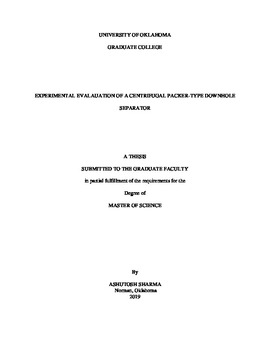| dc.contributor.advisor | Karami, Hamidreza | |
| dc.contributor.author | Sharma, Ashutosh | |
| dc.date.accessioned | 2019-12-13T21:58:00Z | |
| dc.date.available | 2019-12-13T21:58:00Z | |
| dc.date.issued | 2019 | |
| dc.identifier.uri | https://hdl.handle.net/11244/323223 | |
| dc.description.abstract | With the ever-increasing decline in production of oil wells, application of artificial lift techniques is becoming inevitable. Beam pumps and electrical submersible pumps are two of the most common artificial lift methods for low and high oil production rates. But these techniques are always susceptible to high gas-oil ratios in production stream. Various types of downhole separators have been designed recently upstream of the pump to resolve this issue and improve the pump efficiency. The objective of this study is to evaluate the performance of a centrifugal downhole separator. For this purpose, a state-of-art experimental facility is constructed to simulate the flow in an oil well with varying gas-oil ratios.
The experimental multiphase flow setup is designed, fabricated and constructed in an efficient and automated way to simulate a typical horizontal wellbore. The well trajectory includes a 31-ft horizontal section, inclinable to ±10o, followed by a 27-ft vertical section. The casing ID is 6-in., and a 2-in. ID tubing is placed inside of it, with end-of-tubing at the bottom of vertical. The casing and tubing streams are each led to a return column, where gas and liquid flows are separated and metered. Automated and modulated control valves are used to monitor the pressure and production from casing and tubing streams. Five Coriolis flow meters quantify density and flow rate of different streams. The experiments are performed with air, supplied by a screw-type compressor, and water, supplied by a Progressive cavity pump.
The tested downhole separator is an innovative design, applying gravity and centrifugal effects to perform the separation. Tests are conducted at a water flowrate range of 17-700 bpd to simulate the cases with both rod pump and ESP operations. Various air-water ratios are tested to identify the range of separator effectiveness. Flow rates of air and water in casing and tubing return lines show the efficiency of the separator in sending the liquid into tubing and gas into casing stream. Experiments indicate that separation efficiency of this novel separator is high. Average gas separation efficiency of the separator is 93% and average liquid separation efficiency is 96%. This separator is suitable for use in horizontal as well as vertical wells, if separator is placed in the vertical section of the well, to stimulate artificial lift equipment`s performance. | en_US |
| dc.language | en_US | en_US |
| dc.rights | Attribution-NonCommercial-NoDerivatives 4.0 International | * |
| dc.rights.uri | https://creativecommons.org/licenses/by-nc-nd/4.0/ | * |
| dc.subject | downhole separator | en_US |
| dc.subject | Multiphase flow | en_US |
| dc.subject | Experimental setup | en_US |
| dc.subject | Packer type separator | en_US |
| dc.subject | Centrifugal downhole separator | en_US |
| dc.title | Experimental Evaluation of a Centrifugal Packer-Type Downhole Separator | en_US |
| dc.contributor.committeeMember | Ahmed, Ramadan | |
| dc.contributor.committeeMember | Teodoriu, Catalin | |
| dc.date.manuscript | 2019-12-13 | |
| dc.thesis.degree | Master of Science | en_US |
| ou.group | Mewbourne College of Earth and Energy::Mewbourne School of Petroleum and Geological Engineering | en_US |

